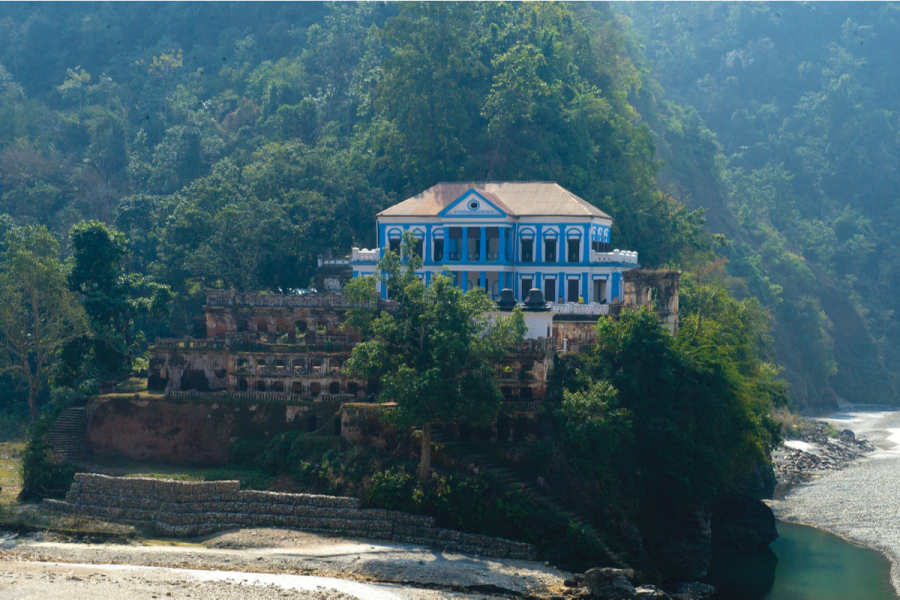Columns
That's one monumental task
Encouraging public-private partnership in the conservation of heritage sites in Nepal.
Roshee Lamichhane
The idea of converting Rani Mahal in Palpa into a heritage hotel sparked controversy among stakeholders last year. Those against turning the old Rana palace into a hotel are mainly cultural experts and historians who compare it with the Taj Mahal in India, and say that conversion will make it lose its charm and authenticity. Proponents, including those from Hotel Association Nepal, believe that setting up new hotels in the vicinity will preserve the beauty and grandeur of the palace. However, any tourist visiting this site would only feel dismayed at its current dilapidated state given the slow pace of renovation. In 2013, the Department of Archaeology decided to restore Rani Mahal, but little has been done so far. Lack of personnel at the department tasked with overseeing the project, and indifference of the contractors has been blamed for the slow progress. It is time the government took a call on the privatisation of heritage sites for their conservation and commercial use.
There are many examples of Rana-era buildings being refurbished into hotels. Research suggests that the conversion of any ancient site is driven by mainly two kinds of incentives—economic and socio-political. Economic incentives are the potential to generate revenue to pay for preservation and profit from tourism. Socio-political incentives are the opportunity for the government to inculcate an 'authorised' vision of history or the potential to reframe the story of people and places in a manner that appeals to tourists.
Socio-economic impact
Nepal has not been able to attract high-quality tourists especially to such unique heritage sites which can be popular tourist destinations. Travellers who look not only for grandeur and affluence but also the authenticity of the past opt for such an experience. However, the challenge of converting Rani Mahal into a hotel and increasing its commercialisation prospects is the unavailability of roads. The road to Rani Mahal via Palpa offers the most direct access, but it takes about an hour to traverse the modest distance of 18 km. Other routes via Mirmi, Syangja can be explored so that locals may benefit from the economic opportunities that would ensue. The construction of heritage hotel would also contribute to the development of basic infrastructures such as the internet and banks. It would also be an opportunity for the area to appear on the global radar.
Once Rani Mahal is converted into a heritage hotel, premium prices can be charged for new and enhanced service offerings. A combination of product offerings such as hiking in the vicinity, boating and rafting in the Kaligandaki River and horse riding can be created. Another source of direct revenue is folk dance performances. Musical performances and other cultural events can also be organised so that the historical significance of the site can be revived and local people can get employment. Tourism will also lead to higher production of raw materials such as vegetables, fruits and dairy products in the region as the current output is not fully consumed by the local economy. By providing proper economic incentives, a meaningful impact can be expected in the lives and livelihoods of local people. Moreover, local handicrafts can be showcased conspicuously inside the hotel premises and successfully promoted as is done in other tourist destinations.
Of late, conservation of heritage sites by allowing and encouraging private players by the federal government under the public-private partnership (PPP) model has become a global trend. The rationale for PPP in the protection of such sites is supported by a number of case studies. Sculpture Park at Madhavendra Palace at Nahargarh Fort, Jaipur which witnessed a 39 percent increase in visitors to the fort since its restoration in 2017 is a successful example. Research evidence suggests that PPP has gained popularity over the last few decades in heritage conservation as governments face challenges in their efforts to conserve and manage their cultural heritage sites.
This is in line with the simple economic principle of opportunity cost as a constraint on resource allocation to heritage projects propounded by English economist Sir Alan Peacock. He argued that heritage projects received less funds in comparison to other projects given budgetary constraints. Today, public resources are deficient in providing the necessary funding, personal skills and resources required to achieve the overall conservation goals. Although governments act as custodians of community heritage resources as per traditional conservation theory, due to multiple and compelling pressure to fulfil other public demands, private engagement and community commitment are needed to retain heritage sites.
Creative new uses
Besides, the efficacy of PPP as an approach to financing, developing, operating and maintaining historic buildings cannot be undermined. Its proven success lies in the involvement of not just public and private players, but also third sectors which consist of non-governmental organisations. Turning long underutilised structures into museums, community centres and hotels, and finding creative new uses for existing structures known as 'adaptive reuse' is what a heritage PPP generally entails to make it a viable proposition. Thus, PPP has become a popular model not only for the initiation and carrying out of conservation, but also for ensuring the sustainability of the place as proven by research in Italy.
The latest amended act, the Ancient Monument Preservation Act 2013, deals with the preservation of cultural and heritage sites, but it fails to mention how routinely such restoration work will be carried out. Also, the budget allotted for the construction of such heritages sites from 2015 to 2020 has been grossly insufficient for periodic maintenance. Thus, sites such as Rani Mahal are in despair and can no longer depend on public money alone for their restoration. Timely decision and action in this regard would be instrumental for ushering in a new era for sustainable tourism in the area.




 13.12°C Kathmandu
13.12°C Kathmandu.jpg)













%20(1).jpg&w=300&height=200)

